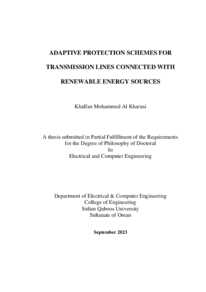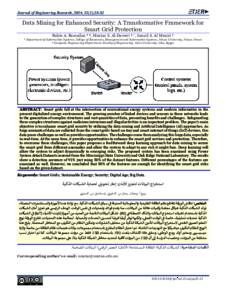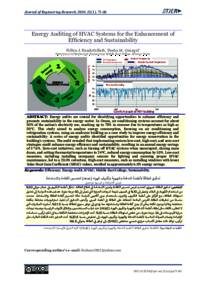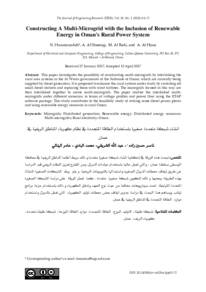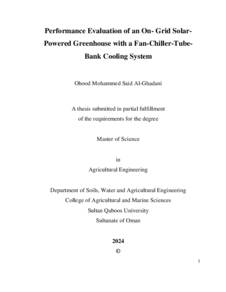Document
Adaptive protection schemes for transmission lines connected with renewable energy sources.
Source
Doctoral dissertation
Other titles
الحماية التكيفية لخطوط النقل المتصلة بمصادر الطاقة المتجددة
Country
Oman
City
Muscat
Publisher
Sultan Qaboos University
Gregorian
2023
Language
English
Thesis Type
Doctoral dissertation
English abstract
Integrating inverter-based renewables in electrical power systems introduces
several challenges to different power subsystems. One of these is the protection system.
The conventional protection system functions may not properly function for different fault
scenarios due to the inverters’ behaviors. The protection system elements of the
transmission lines connected to inverter-based generators need to be designed to cope with
the different changes experienced by the power system, such as the penetration level, the
reduction of inertia, the lack of zero and negative-sequence components, and the changing
source impedance. Different techniques can be used to mitigate these changes. Adaptive
protection schemes are the most common of these.
The proposed adaptive schemes in this research are Machine Learning (ML)-based.
They are mostly related to detecting and classifying electrical faults in the transmission
lines connecting inverter-based generators, namely photovoltaic (PV) systems and doublyfed induction generator (DFIG) wind turbines. The 39-bus power system was used as the
transmission system network and to extract the power signals.
Two adaptive methodologies were considered. The first selects the appropriate pretrained and pre-optimized classifier by monitoring the circuit breaker status and the active
power of the generators' outputs behind the protected transmission line to identify the
power system topology. This is basically a lookup table approach that inputs the circuit
breaker's status (to identify which generator is connected to the grid) and the output active
power of the generator (to detect which generators are active). The second adaptation
scheme uses incremental learning as an adaptation mechanism.
The incremental learning process uses the measured voltages and currents online
(data stream) to update the parameters of the classification model associated with data drift
detection and self-labeling models. This data-driven approach is used to minimize the time
in the updating mode, which reduces computational complexity and increases the speed of
detection and classification. The main aim of the incremental is to maintain the efficiency
of the fault detector in the face of changing the statistical characteristics of the data and to
do that without human interference.
The main features of this research can be summarized as follows. It updates the
literature on the impact of inverter-based generators on power system protection elements
and the mitigation approaches concentrating on using artificial intelligence-based
techniques. In addition, it utilizes a wide range of ML algorithms to detect and classify
different types of faults in transmission lines connected to IBGs. Furthermore, it
investigates the impact of data imbalance, which is essential when considering power
system faults as minority events. It also proposes two fault detection and classification
techniques for adaptive protection design approaches considering the ML algorithms.
Finally, it deals with data streams by having data drift detection and labeling using
Hoeffding’s inequality theory and self-training self-labeling semi-supervised model as part
of the ML-based power system protection scheme.
When compared to similar methodologies from the literature, the findings
demonstrated a competitive performance. The incremental learning strategy with the
suggested ftting and updating criteria has exceptional performance in terms of retraining
time and detection and classification accuracy.
Arabic abstract
يقدم دمج مصادر الطاقة المتجددة القائمة على العاكس في أنظمة الطاقة الكهربائية العديد من التحديات في ا به في أي حالة من حالات النظام. قد جوانب مختلفة. أحد هذه الجوانب هو نظام الحماية الذي يجب أن يكون موثوقً تتعطل وظائف الحماية التقليدية لسيناريوهات الاعطال المختلفة بسبب السلوك المختلف للشبكة عند ربطها بهذا النوع من المولدات. يجب تصميم عناصر الحماية لخطوط النقل المتصلة بالمولدات القائمة على العاكس لمواكبة التغيرات التي يمر بها النظام الكهربائي، مثل تغير مستويات الانتاج المتغيرة لهذه المولدات، ونقصان عزم الشبكة الذاتي، ونقص مكونات التسلسل الصفري والسالب، وتغير معاوقة المصدر. تقنيات مختلفة يمكن أن تخفف من تأثير هذه التغيرات؛ ومن أهمها استعمال أنظمة حماية تكيفية والتي تعتبر الاكثر شيوعا. يعتمد المخطط التكيفي المقترح في هذا البحث بشكل أساسي على تطبيقات تعليم الالة الكتشاف وتصنيف الاعطال الكهربائية في خطوط النقل المتصلة بنوعين شائعين من المولدات القائمة على العاكس )أنظمة الطاقة الشمسية الكهروضوئية وتوربينات الرياح مزدوجة الحث(. تم النظر في اثنين من المنهجيات التكيفية. الاول كان يعتمد على التكيف باستخدام اختيار مجموعة الاعداد )Groups Setting )حيث تم استخدام حالة قاطع الدائرة والقياس المستمر للطاقة الخارجة المولدات المتصلة خلف خط النقل المحمي لتحديد أشكال النظام. وفي هذه الطريقة تم تحديد مجموعة الاعداد الخاصة لكل شكل باستخدام نماذج تصنيف تعليم الالة المح سن مع اختيار مجموعة الميزات المحددة )features). وأما الطريقة الثانية فتعتمد على استخدام نهج التعلم المتزايد )learning incremental). تم تجهيز نماذج التعلم المتزايدة وتحديثها مع تدفقات البيانات الجديدة. وقبل تغذية نموذج التعلم المتزايد مع تدفقات البيانات، تم استخدام نموذج كاشف انحراف البيانات )model detection Drift Data )ونموذج لتوسيم ك م البيانات البيانات الجديدة ) model labeling Data). تم استخدام نموذج اكتشاف انحراف البيانات للحد من مقدار المقدمة للنماذج المتزايدة، مما يحسن من مراقبة البيانات ويقلل العبء الحسابي. من ناحية أخرى، تم نشر خوارزمية التوسيم الذاتي للتخلص من حاجة الخبراء البشريين إلى تصنيف البيانات الواردة. تم اختبار فاعلية النظام المط ور في ظروف مختلفة للنظام الكهربائي، مثل تغير مستويات الانتاج المتغيرة لهذه المولدات، وتغيير مواقع الاعطال، وطوبولوجيا النقل، وطوبولوجيا التوليد. بالاضافة إلى ذلك، تمت مقارنتها ا. ًء متمي ًزا مقارنة بأساليب التعلم الالي المطبقة سابقً بالطرق المختلفة في الابحاث السابقة، وقد أظهرت النتائج أدا يمكن تلخيص السمات الرئيسية لهذا البحث على النحو التالي. أولا، يقوم بتحديث الدراسات السابقة المتعلقة بتأثير المولدات المعتمدة على العاكس على عناصر حماية نظام الطاقة وأساليب التخفيف من اثارها والتي تركز على استخدام التقنيات القائمة على الذكاء الاصطناعي. بالاضافة إلى ذلك، فإنه يستخدم مجموعة واسعة من خوارزميات تعليم الالة الكتشاف وتصنيف أنواع مختلفة من الاعطال في خطوط النقل المتصلة بالمولدات الموصولة بالعواكس. علاوة على ذلك، فهو يدرس تأثير عدم توازن البيانات، وهو أمر ضروري عند اعتبار أ عطال نظام الطاقة الكهربائية كأحداث قلية الحدوث. كما يقترح طريقتين لتصميم الحماية التكيفية مع الاخذ في الاعتبار خوارزميات التعلم الآلي. أخيرا، يتعامل مع تدفقات البيانات من خالل اكتشاف انحراف البيانات ووضع العالمات عليها باستخدام نظرية هوفدينج ونموذج التدريب الذاتي كجزء من نظام حماية الشبكة الكهربائية القائم على التعلم المتزايد. ًء تنافسيًا، كما أن استراتيجية عند مقارنتها بمنهجيات مماثلة من الدراسات السابقة، أظهرت نتائج البحث أدا التعلم التزايدي مع معايير التصحيح والتحديث المقترحة تتمتع بأداء استثنائي من حيث وقت إعادة التدريب ودقة الكشف والتصنيف.
Category
Theses and Dissertations

